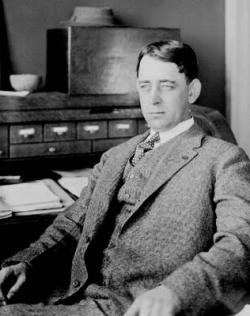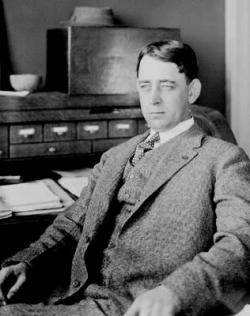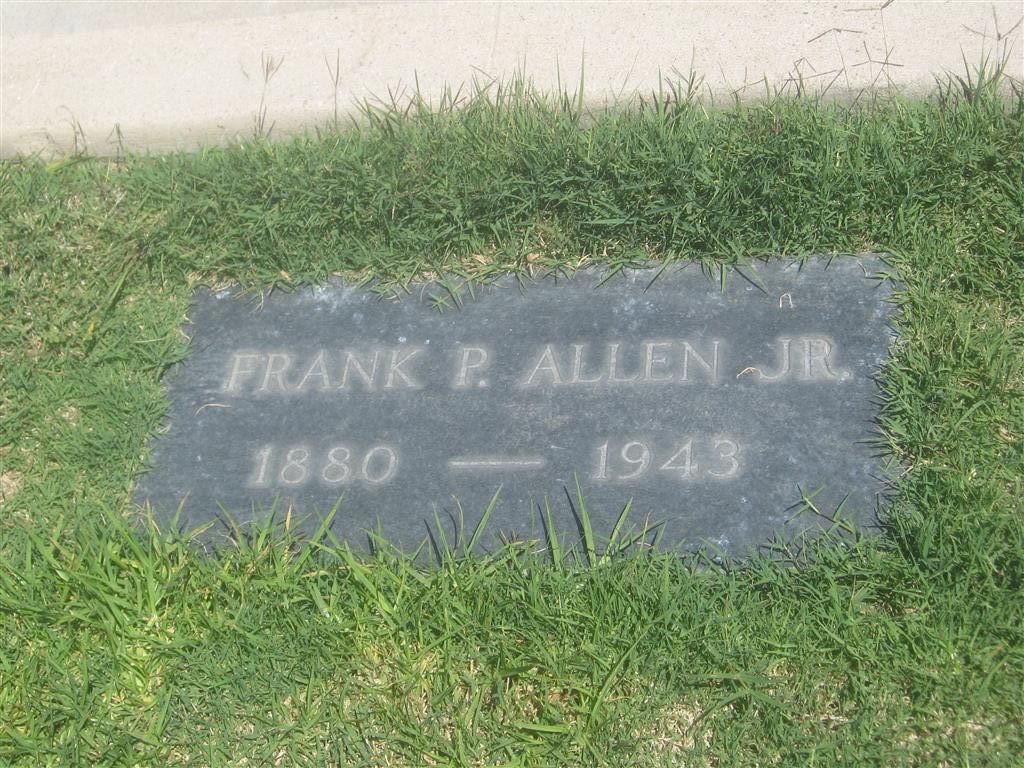Frank P. Allen, Jr., came to San Diego in 1911 to work on the Panama-California Exposition and left an indelible imprint on the architecture and landscape of the city. By profession, he labored as an architect, contractor, and engineer, as well as a sensitive self-taught landscape designer.
Born in Grand Rapids, Michigan, in 1881 to Frank P. and Mary Allen, Allen received early training in the architectural field under the tutelage of his father, a Michigan architect. In his early twenties, after a stint in the Spanish-American War, Allen and his father practiced architecture in Grand Rapids under the firm name of Frank P. Allen & Son.
After Allen's tenure with his father, he moved to Chicago in the early 1900s where he worked as a draftsman with Daniel Burnham. Allen left Chicago in 1904 and headed west. Employed with a Seattle architect, he decided to open his own architectural/contracting office. He received a contract for the nine-story Perry Hotel and completed it in unheard of time-two months and two days. He served as consulting engineer to Portland's Lewis and Clark Exposition, held in 1905. His accomplishments in Portland led to his employment as the Director of Works for the Seattle exposition which opened in 1909. Seattle wanted "a man who could work fast and save." Allen was given two and one half years to complete his portion of the work for the exposition. He finished it in one year and ten months.
Allen was hired as the Director of Works for the Panama-California Exposition in January 1911. His first order of business involved the topographical survey of the area which he felt needed to be completed before the arrival of Bertram Goodhue, the noted New York and Boston architect. Allen found fault with the Olmsted recommendation of an exposition set along the Florida canyon site and proposed the actual site, "pointing out its advantages from a scenic point of view." But exposition directors fought him, arguing "it would be impractical to build a bridge over the Cabrillo canyon, that the cost would be too great." Allen demonstrated that his plans would be cost-effective, and in the end he won his battle. Allen "volunteered to shoulder the responsibility" for the exposition planting. He implemented an irrigation system for the park and devised a landscaping plan. One of Allen's earliest exposition projects involved the construction of the Cabrillo Bridge, built of reinforced concrete at a cost of $225,154, extended 916 feet across the canyon. With great ceremony, the bridge was dedicated April 12, 1914, and the first person to ride across it was Franklin D. Roosevelt, then Assistant Secretary of the Navy. Allen contributed his architectural, engineering, and horticultural expertise to a number of other park designs. He provided the practical or engineering requirements for the exposition Administration Building, designed in 1911 by Carleton M. Winslow. He also planned the Montezuma Gardens and the Doric-style Pergola near the California Building. Allen designed the two-story Sacramento Valley Building, also known as the United States Building, which was located at the north side of the main plaza of the exposition. Allen drew plans for the Canadian Building and the arcade which connected the portales, and designed the San Joaquin Valley Building.
Allen left San Diego in 1917 but returned two years later. He designed and built the Park Manor near Balboa Park at 6th and Spruce in 1925; Allen and his wife, Mabel, lived there. They divorced in 1931 and Allen moved to Los Angeles in 1932. He died an accidental death on July 5, 1943 at the age of 63.
___________________________________
Master Architect - Frank Phillips Allen, Jr., who came to San Diego in 1911 to work on the Panama-California Exposition, left an indelible imprint on the architecture and landscape of the city. By profession, he labored as an architect, contractor, and engineer, as well as a sensitive self-taught landscape designer. His contributions to San Diego's architectural history reflect the accomplishment of a master in his field. He pioneered no new building style, but designed many substantial structures that were meant to last. Indeed, the remains of his work in this city attest to his achievement as a consummate architect who dealt with all building phases, including the design, engineering and contracting aspects, as well as the general site planning.
In 1932, Allen moved to Los Angeles. He remarried sometime after 1940 and his last known employment was as an engineer-draftsman for Liberty Ship construction with the California Shipbuilding Corporation in Wilmington.
He died an untimely death at the age of 63 on July 5, 1943, when he was run over by a heavy motorized lumber carrier as he walked from behind a pile of steel girders. Cremation followed funeral services at Forest Lawn Mortuary in Glendale
source: San Diego History.org
Frank P. Allen, Jr., came to San Diego in 1911 to work on the Panama-California Exposition and left an indelible imprint on the architecture and landscape of the city. By profession, he labored as an architect, contractor, and engineer, as well as a sensitive self-taught landscape designer.
Born in Grand Rapids, Michigan, in 1881 to Frank P. and Mary Allen, Allen received early training in the architectural field under the tutelage of his father, a Michigan architect. In his early twenties, after a stint in the Spanish-American War, Allen and his father practiced architecture in Grand Rapids under the firm name of Frank P. Allen & Son.
After Allen's tenure with his father, he moved to Chicago in the early 1900s where he worked as a draftsman with Daniel Burnham. Allen left Chicago in 1904 and headed west. Employed with a Seattle architect, he decided to open his own architectural/contracting office. He received a contract for the nine-story Perry Hotel and completed it in unheard of time-two months and two days. He served as consulting engineer to Portland's Lewis and Clark Exposition, held in 1905. His accomplishments in Portland led to his employment as the Director of Works for the Seattle exposition which opened in 1909. Seattle wanted "a man who could work fast and save." Allen was given two and one half years to complete his portion of the work for the exposition. He finished it in one year and ten months.
Allen was hired as the Director of Works for the Panama-California Exposition in January 1911. His first order of business involved the topographical survey of the area which he felt needed to be completed before the arrival of Bertram Goodhue, the noted New York and Boston architect. Allen found fault with the Olmsted recommendation of an exposition set along the Florida canyon site and proposed the actual site, "pointing out its advantages from a scenic point of view." But exposition directors fought him, arguing "it would be impractical to build a bridge over the Cabrillo canyon, that the cost would be too great." Allen demonstrated that his plans would be cost-effective, and in the end he won his battle. Allen "volunteered to shoulder the responsibility" for the exposition planting. He implemented an irrigation system for the park and devised a landscaping plan. One of Allen's earliest exposition projects involved the construction of the Cabrillo Bridge, built of reinforced concrete at a cost of $225,154, extended 916 feet across the canyon. With great ceremony, the bridge was dedicated April 12, 1914, and the first person to ride across it was Franklin D. Roosevelt, then Assistant Secretary of the Navy. Allen contributed his architectural, engineering, and horticultural expertise to a number of other park designs. He provided the practical or engineering requirements for the exposition Administration Building, designed in 1911 by Carleton M. Winslow. He also planned the Montezuma Gardens and the Doric-style Pergola near the California Building. Allen designed the two-story Sacramento Valley Building, also known as the United States Building, which was located at the north side of the main plaza of the exposition. Allen drew plans for the Canadian Building and the arcade which connected the portales, and designed the San Joaquin Valley Building.
Allen left San Diego in 1917 but returned two years later. He designed and built the Park Manor near Balboa Park at 6th and Spruce in 1925; Allen and his wife, Mabel, lived there. They divorced in 1931 and Allen moved to Los Angeles in 1932. He died an accidental death on July 5, 1943 at the age of 63.
___________________________________
Master Architect - Frank Phillips Allen, Jr., who came to San Diego in 1911 to work on the Panama-California Exposition, left an indelible imprint on the architecture and landscape of the city. By profession, he labored as an architect, contractor, and engineer, as well as a sensitive self-taught landscape designer. His contributions to San Diego's architectural history reflect the accomplishment of a master in his field. He pioneered no new building style, but designed many substantial structures that were meant to last. Indeed, the remains of his work in this city attest to his achievement as a consummate architect who dealt with all building phases, including the design, engineering and contracting aspects, as well as the general site planning.
In 1932, Allen moved to Los Angeles. He remarried sometime after 1940 and his last known employment was as an engineer-draftsman for Liberty Ship construction with the California Shipbuilding Corporation in Wilmington.
He died an untimely death at the age of 63 on July 5, 1943, when he was run over by a heavy motorized lumber carrier as he walked from behind a pile of steel girders. Cremation followed funeral services at Forest Lawn Mortuary in Glendale
source: San Diego History.org
Family Members
Sponsored by Ancestry
Advertisement
Advertisement











